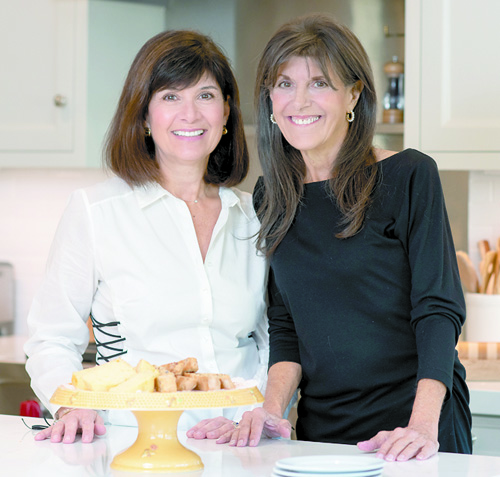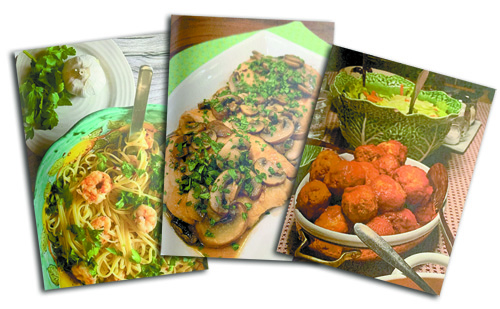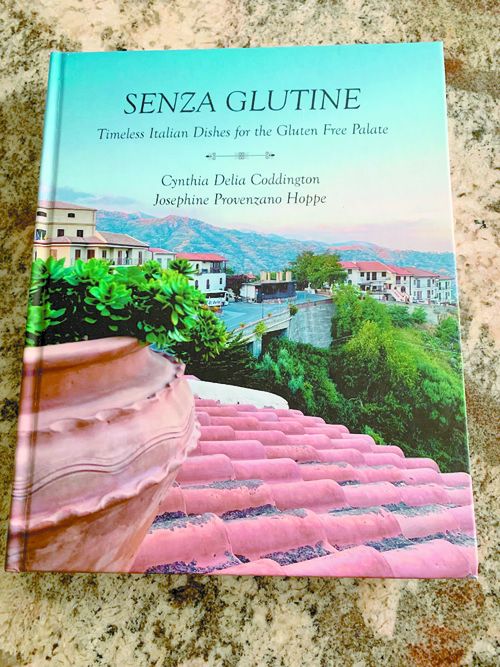Creating & Cooking … the gluten free way

By Wayne E. Rivet
Staff Writer
Being diagnosed with Celiac Disease or Gluten Intolerance is akin to receiving a dietary life sentence characterized by mushy gluten-free pasta, bread the consistency of cardboard, and the penalty of forever being dependent on scrutinizing food labels.
Cynthia Delia Coddington and Jo Provenzano Hoppe — both Italian-American women — were diagnosed with gluten intolerance as adults.
“It has been affectionately noted that when Italians are not eating good food, they are talking about it,” they said.
The two women’s paths crossed in 2019 when they became neighbors on a rural fire lane in Bridgton.
Jo and her husband, Henry, had just sold their home and retired to Bridgton, where Cynthia and her family had a residence. Cynthia and Jo quickly discovered that they had many things in common. Both of the women came from southern Italian roots, their families originated in Brooklyn. Both were studying the Italian language. Both had spent their professional lives in Massachusetts (Cynthia in Finance, Jo in Technology). And, more importantly, both shared a genuine passion for cooking.
How does on balance a love for cooking, especially Italian recipes calling for pasta, with the challenges of a gluten-free diet?
“While gluten free breads and pasta were starting to show up on grocery shelves, they were, and for the most part continue to be, either tasteless or gummy versions of their wheat-based counterparts,” they said.

Determined to solve this problem, the women embarked on a mission to recreate the wonderful meals they’d come to love using gluten-free ingredients. Their goal was to create gluten-free versions that were indistinguishable from their wheat-based counterparts.
“It was a big undertaking,” they found.
Initially, this effort took the form of co-authoring a family cookbook, but as their collection of recipes continued to grow, both came to realize that their book might help the many others diagnosed with gluten intolerance. The book’s recipes, illustrated techniques, and information on how to source the best gluten-free products are equally helpful to those either just starting their gluten free journey or those simply longing for diversity in their otherwise bland gluten-free diet.
The fruit of Jo and Cynthia’s effort is a newly-released cookbook entitled, “Senza Glutine: Timeless Italian Dishes for the Gluten Free Palate.” The book is available on Amazon and at selected local bookstores, including Bridgton Books.
“The true measure of success is to serve up a meal to guests and to pleasantly surprise them when they learn the meal they just devoured was gluten free,” the authors said. “For those of you suffering from gluten intolerance, the authors hope this book will liberate you from the bondage of gluten intolerance and allow you to once again enjoy great tasting meals.”

The News recently posed the following questions to the authors:
BN. When/how did you discover you have a gluten intolerance?
Jo: I was diagnosed with gluten intolerance approximately 11 years ago, following surgery for an unrelated condition. For over a month, I had been experiencing chronic stomach pain and gastrointestinal issues which became debilitating as time went on. I sought medical assistance and was directed to Dr. Fasano at Mass General. Dr Fasano, one of the world’s leading experts and researchers on gluten intolerance, performed a number of tests which identified my diagnosis – gluten intolerance with a high likelihood of it being Celiac given my Italian heritage, symptoms and other test results. From the doctor, I learned that there is no treatment for gluten intolerance or Celiac Disease, other than eliminating wheat and gluten completely from one’s diet. Failure to do so severely damages the villi in your intestine, making it difficult to digest milk products (lactose intolerance). If left untreated for longer periods of time, gluten intolerance and Celiac Disease can lead to other serious autoimmune diseases.
Learning that one is gluten intolerant is difficult enough, but for Italians whose diets are rich in pasta, pizza and other whole grains, this was a life-changing prognosis. And yet, 1 in 10 children in Italy are born with Celiac Disease or gluten intolerance. It is not surprising, then, that viable and delicious alternatives would eventually emerge from Italy.
Many of the gluten free foods served in most restaurants in Italy are not widely known or available in the United States. Our book includes a chapter entitled “The Gluten Free Pantry” that identifies these products and how to source them here in the US.
Cindy: About 12 years ago, I was diagnosed with an autoimmune condition called Hashimoto’s that was the cause of an underactive thyroid. Because gluten is inflammatory and can trigger an autoimmune reaction, it was recommended that I eliminate it from my diet. For an Italian, this is a tall order and in fact, my response to my doctor was “you don’t understand, I’m Italian, we eat pasta and bread!” And then the hunt began…
BN. How difficult is it to switch to a gluten-free diet, especially because you love to cook. What changes did you make?
Jo: In responding to this question, it must be taken into account that our gluten-free journeys coincidentally commenced almost 12 years ago when not much was known about gluten disorders. There were preciously few gluten free products on the market, and restaurant staffed looked at you in bewilderment when you inquired whether a dish contained wheat or gluten. Cindy and I had not met until years later, so it was astonishing to find a kindred Italian spirit who also had been pioneering on a similar journey. When we learned of each other’s backgrounds, our love of all things culinary, and the medical condition that had fundamentally changed our lives, we came to the conclusion that we were twins by different mothers. And that is when all the fun began….. researching, experimenting, documenting our findings, using our family members as guinea pigs.
While so much more is known today about gluten intolerance, gluten remains an insidious little culprit which hides in many foods under different aliases. Who would suspect that gluten is the primary ingredient in soy sauce or that it is contained in many spices, sauces, packaged chicken broth, frozen French-fried potatoes, grated soft cheeses, beer, malt and many liquors? Many foods that contain “modified food starch” actually contain wheat (unless labeled “modified food starch (corn).” For many with gluten intolerance, we learned these things the hard way – getting seriously ill and trying to understand what trigged the attack.
While our book contains lots of good information on the foods to avoid, we are also developing a website specifically designed to help those beginning on this journey. We’re hoping that what we learned in our journey will help those, who like us many years ago, learned of their condition and wondered, “now what?”
Cindy: The first step in adapting to a gluten free diet is the most difficult. Becoming familiar with new ingredients, products and carefully reading labels can be daunting at first but is necessary to comply with a gluten free diet. The Internet now has a wealth of information and is helpful in familiarizing someone new to the gluten free world.
Not knowing where to start, I scoured the supermarkets for quality gluten free products which at the time were scarce, expensive and of sub-par quality. Unfortunately, I ended up reducing my pasta consumption and replacing it with rice and other naturally gluten free grains. More recently, I’ve discovered Italian made gluten free pastas that are delicious and indistinguishable from their gluten equivalents. In addition, I experimented with grains such as quinoa, sorghum, and millet, all of which are naturally gluten free, and cooked with them in both savory and sweet dishes. For example, quinoa can easily replace bulghur wheat in the traditional middle eastern dish of tabouli. Sorghum can be cooked and served as a stand in for couscous and millet has a slightly sweet taste easily used in cold summer salads.
Some gluten free foods are processed, and replacing what I couldn’t eat with processed food wasn’t a healthy exchange, so I focused on eating naturally gluten free.
Becoming familiar with the properties of gluten free flours is also an important step. For example, almond and sorghum flour, to name a few, work well in baking in place of all-purpose flour, though this requires time and patience to arrive at the right proportions. Gluten free flour mixes commonly sold in grocery stores are now widely available and good quality. Instead of making my own flour mixes, I’ve come to rely on those produced by well-known sources such as King Arthur Flour, Bob’s Red Mill and Cup4Cup.
BN. How did you decide to embark on authoring a book and what became your goal?
Jo/Cindy: We are “accidental” cookbook authors originally setting out to gather and document our collection of family recipe favorites for our children and posterity. We’d not given any thought to commercially publishing our combined collection. Rather we viewed it as a way to honor the amazing women who shaped our lives and our love of good, wholesome food, family, and friends: our mothers, our grandmothers and our aunts.
In January of 2021, we enrolled in a six-week online cookbook writing class to ease our Covid lockdown fatigue and to satisfy our craving for a creative outlet. When mentioning our project to friends, it became apparent that what we were offering could greatly help those either at the beginning of a gluten free lifestyle or reinvigorate those already following one. It was at that point that our focus broadened to include a wider audience with the intent of publishing the book.
BN. What were some of your biggest challenges?
Jo/Cindy: The process of gathering recipes, testing, and serving them to family was fun and rewarding. Family recipes led to stories about our shared heritage. As our book took shape, our husbands complained that they never enjoyed a hot meal anymore because we always had to photograph the dish for the cookbook before serving. Having a kindred spirit, who shared the same goal of developing the memorable meals served at our mother’s tables, but “senza glutine,” made the journey less lonely and more rewarding.
The creative part of writing this book (developing the recipes, taking the photos, and capturing the family stories that were associated with the recipe) was actually the most enjoyable aspect of the project. Our biggest challenge was learning about self-publishing and evaluating the options for printing and distribution. It’s a fragmented industry dominated by online businesses with a DIY approach. For the nascent author, this required a steep learning curve.
BN. How did you approach co-authoring?
Jo/Cindy: Each of us collected favorites, compared notes, and tried out recipes together and individually. We identified criteria for inclusion in the book for uniformity. It was also important to us to include many recipes for the home cook not having the time to mix his/her own gluten free flours.
Because of our common heritage, we decided to limit this cookbook to gluten-free Italian specialties since that was the initial focus of our undertaking: leaving our children (and theirs) a wonderful chronicle of the loving meals prepared by their ancestors that had been handed down through the generations.
From a technical perspective, when we could not be together to collaborate, we created a Google Drive site with folders for recipes, photos, recipe test feedback, publishing and distribution information and a template for each recipe to ensure formatting consistency. All files were sharable. We also utilized Zoom and other technologies to solicit feedback from other authors and publishing contacts.
BN. My understanding is that a lot of research went into developing the recipes, elaborate?
Jo/Cindy: Finding the best products required research on foot and online. We spent much time experimenting with different ingredients and in different proportions. This is especially true for the baked goods included in the book. Gluten is the substance that provides both texture and elasticity to breads and doughs. In eliminating gluten from a recipe, the result is usually bread or pizza dough that tastes like cardboard or pie crust that falls apart. We were determined to solve this problem.
To address these issues, we needed to learn about various stabilizers and binding agents like xanthan gum and psyllium husk and when to use each one for the best results. I recall one afternoon we spent trying out various pizza dough recipes to arrive at one that could then be used as a base from which to improvise. Becoming familiar with ingredients and more importantly texture is critical in developing new recipes.
BN. What do you like most about this book?
Jo/Cindy: The book provides a roadmap for those embarking on a gluten free lifestyle, but what I like most about this experience is sharing a very personal story akin to a culinary family album. All the photographs in the book (except for our author portraits) were taken by us and include favorites from our recent trip to southern Italy, specifically Sicily and Puglia, the regions of our family origins.
BN. What is your favorite recipe and why?
Cindy: Spaghetti with Garlic and Oil – It’s a very flavorful dish and one that captures the essence of Italian cuisine – using fresh ingredients, simply prepared.
Jo: This is a very difficult question. I have favorites in all the categories (a favorite pasta dish: Tagliatelle with Mushrooms and Truffle Oil; a favorite potato dish: potato croquettes; a favorite vegetable dish: stuffed artichokes; a favorite appetizer: baked clams oreganata; and a favorite dessert: panna cotta).
BN. As you mention in the press release, the greatest test of a very good gluten-free dish is how it is received by others who do not have a gluten intolerance. What have been some of the responses you’ve received?
Jo/Cindy: There’s nothing more satisfying than serving a gluten free dish to someone not having an intolerance. We often see a look of disbelief after announcing to a dinner guest that the entire meal was gluten free. It’s a misconception that taste must be sacrificed for health.
BN. Finally, any other future undertakings planned?
Jo/Cindy: We are in the process of building an educational web site with helpful information on gluten intolerance. We are also mulling over some future book ideas.
Watch this space…

